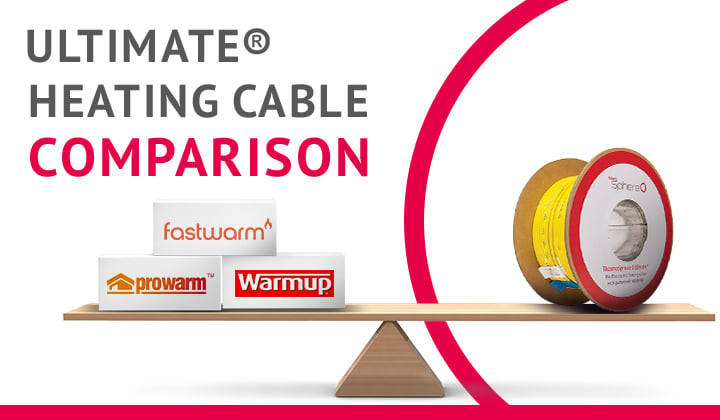ThermoSphere running cost calculator
 Perhaps the easiest way you can go about working out your running costs is using this handy tool on our website. The ThermoSphere running cost calculator provides approximate daily running costs, which we keep regularly updated. It assumes your system is installed as the primary heat source in a well‑insulated dwelling, built to current Part L regulations, with a 10 mm floor covering and 10 mm insulation board underneath. It also presumes control via an intelligent programmable thermostat with a floor sensor and a floor temperature set to 24 °C. We know that's a lot of technical words that some, but not all, will understand. But it basically means "on average".
Perhaps the easiest way you can go about working out your running costs is using this handy tool on our website. The ThermoSphere running cost calculator provides approximate daily running costs, which we keep regularly updated. It assumes your system is installed as the primary heat source in a well‑insulated dwelling, built to current Part L regulations, with a 10 mm floor covering and 10 mm insulation board underneath. It also presumes control via an intelligent programmable thermostat with a floor sensor and a floor temperature set to 24 °C. We know that's a lot of technical words that some, but not all, will understand. But it basically means "on average".
Energy costs will vary depending on a multitude of factors:
- Wattage output of your underfloor heating
- Local energy tariffs
- Room temperature
- Insulation levels and heat losses
- Thermostat usage
So bear these things in mind when working out any costs. But the figures you get on this calculator are an excellent place to start and a pretty good benchmark for what you can expect (if we do say so ourselves).
✖️➗ Running Cost Calculator ➗✖️
Current UK electricity prices (Autumn 2025)
 At the time of writing, the Ofgem energy price cap sets the average electricity unit rate for standard variable tariffs at 25.73 p/kWh, with a standing charge of 51.37 p per day.
At the time of writing, the Ofgem energy price cap sets the average electricity unit rate for standard variable tariffs at 25.73 p/kWh, with a standing charge of 51.37 p per day.
Accurate at the date of publishing, see link below.
Looking ahead to the end of 2025, this will rise slightly to 26.35 p/kWh and 53.68 p/day respectively, per the upcoming October 2025 price cap.
More information and a reference for these figures can be found below.
Electricity will always rise in price. Along with everything else in the world. But if you are smart with your usage, which isn't as hard as you might think, then underfloor heating can not only be affordable but actually often cheaper than some alternatives.
💲📈 July - Sep 2025 Ofgem 📉💲 💸📝 Jump To Money Saving 📝💸 💲📈 Oct - Dec 2025 Ofgem 📉💲
Example scenario: ThermoSphere Ultimate & Membrane (10m², 130W cable)
 To put some numbers into context, let’s look at a 10m² room using ThermoSphere Ultimate® heating cable paired with a decoupling membrane.
To put some numbers into context, let’s look at a 10m² room using ThermoSphere Ultimate® heating cable paired with a decoupling membrane.
When installed at a spacing that delivers 130W/m², the total system load comes to 1.3 kW. At the current UK average electricity price of 25.73 p/kWh, this works out as:
-
33.5p per hour of operation (1.3 kW × 25.73p/kWh).
-
If the system runs for 3 hours per day, that’s roughly £1.01 per day.
-
Over a 30-day month, the cost comes to about £30.30.
These are, of course, average figures based on typical usage and the current Ofgem price cap. Real-world running costs will vary depending on your insulation levels, how you use your thermostat and how well your home retains heat. But this gives a solid benchmark for budgeting and you can refine it further with the ThermoSphere Running Cost Calculator, which tailors the estimate to your exact setup. If you want to talk to someone about this or work together to get an even closer estimate, please don't hesitate to get in touch below.
😁📞 Contact Us 📞😁
Does cable output affect running costs?
 One of the most common assumptions about electric underfloor heating is that a higher-wattage cable will automatically cost more to run. On the surface, it makes sense: higher wattage means more power, so surely that must mean higher bills? But in practice, it doesn’t work that way.
One of the most common assumptions about electric underfloor heating is that a higher-wattage cable will automatically cost more to run. On the surface, it makes sense: higher wattage means more power, so surely that must mean higher bills? But in practice, it doesn’t work that way.
The key point is this: heating a room from say, 15°C to 21°C requires the same total amount of energy, whether the system is 130W/m² or 195W/m². What really influences running costs is the amount of heat lost from the space, which depends on things like wall and floor insulation, glazing quality and how airtight the room is.
So, what does wattage actually change? Speed. A higher-wattage cable, such as 195W/m², will bring the room up to temperature faster than a 130W/m² system. This can be especially useful in spaces where you want warmth quickly—like bathrooms or ensuites. But once the target temperature is reached, the thermostat begins cycling the system on and off to maintain comfort, no matter the output rating.
In short: wattage affects how quickly the system heats the room, not how much it costs to maintain comfort over time, especially when paired with good insulation and a smart thermostat.
🔷⭐ ThermoSphere Ultimate® heating cable ⭐🔷
Factors that reduce running costs
 The overall insulation and airtightness of your home has one of the biggest impacts on day-to-day energy use. A well-sealed property -good glazing, insulated walls, loft insulation, holds onto warm air for longer meaning your ThermoSphere Ultimate® system doesn’t need to switch on as often. In contrast, draughty or poorly insulated spaces allow heat to escape quickly, forcing the heating to work harder just to maintain a steady temperature. Improving your building’s insulation benefits not only your underfloor heating but also your overall energy bills year-round.
The overall insulation and airtightness of your home has one of the biggest impacts on day-to-day energy use. A well-sealed property -good glazing, insulated walls, loft insulation, holds onto warm air for longer meaning your ThermoSphere Ultimate® system doesn’t need to switch on as often. In contrast, draughty or poorly insulated spaces allow heat to escape quickly, forcing the heating to work harder just to maintain a steady temperature. Improving your building’s insulation benefits not only your underfloor heating but also your overall energy bills year-round.
Smart, programmable thermostats are another key factor. By giving you the ability to set schedules and control floor temperatures with precision, they ensure the system only runs when it’s genuinely needed. This avoids the common pitfall of over-heating a room and wasting energy, while still keeping comfort levels high. In well insulated homes, where warmth lingers for hours, a good thermostat makes sure that efficiency is maximised without any loss of comfort.
Beneath the floor, insulation boards play an equally important role. They prevent heat from escaping into the subfloor and help the system direct warmth upwards into the room where it’s useful. In practice, this can almost halve the energy required to reach and maintain a comfortable temperature. That means faster warm-up times, lower electricity consumption and a system that doesn’t have to work as hard in the long run.
Even small tweaks can make a noticeable difference. For example, in a 10m² bathroom, reducing your thermostat setting by just 1°C could save around £30 per year on your energy bills. Simple measures like this, when combined with good insulation and smart controls, can significantly reduce the running costs of ThermoSphere Ultimate®.
🔄💰 Save Money On EUFH 💰🔄
Final thoughts
For a 10m² ThermoSphere Ultimate® with Membrane system running at 130W/m², you can expect average daily costs of around 95p–£1.15, when run for 3-4 hours. It’s a modest running cost for the comfort of warm tiles, quick heat-up times and a system built with longevity in mind.
Thanks to the TwistedTwin cable construction, the discreet in-line joint and the secure base of the Membrane, you’re not just getting efficiency. You’re investing in a system designed for consistent performance, minimal maintenance and dependable value over the long term.
❓📊How much does it cost?📊❓ ❓📊Upfront Costs📊❓
❓📊Cost Comparison 📊❓ ❓📊Is It Worth It (ROI) 📊❓
Electric heating made easy



















 Jacob Bottley
Jacob Bottley

 Perhaps the easiest way you can go about working out your running costs is using
Perhaps the easiest way you can go about working out your running costs is using At the time of writing, the Ofgem energy price cap sets the average electricity unit rate for standard variable tariffs at 25.73 p/kWh, with a standing charge of 51.37 p per day.
At the time of writing, the Ofgem energy price cap sets the average electricity unit rate for standard variable tariffs at 25.73 p/kWh, with a standing charge of 51.37 p per day.  To put some numbers into context, let’s look at a 10m² room using
To put some numbers into context, let’s look at a 10m² room using  One of the most common assumptions about electric underfloor heating is that a higher-wattage cable will automatically cost more to run. On the surface, it makes sense: higher wattage means more power, so surely that must mean higher bills? But in practice, it doesn’t work that way.
One of the most common assumptions about electric underfloor heating is that a higher-wattage cable will automatically cost more to run. On the surface, it makes sense: higher wattage means more power, so surely that must mean higher bills? But in practice, it doesn’t work that way. The overall insulation and airtightness of your home has one of the biggest impacts on day-to-day energy use. A well-sealed property -good glazing, insulated walls, loft insulation, holds onto warm air for longer meaning your
The overall insulation and airtightness of your home has one of the biggest impacts on day-to-day energy use. A well-sealed property -good glazing, insulated walls, loft insulation, holds onto warm air for longer meaning your 

